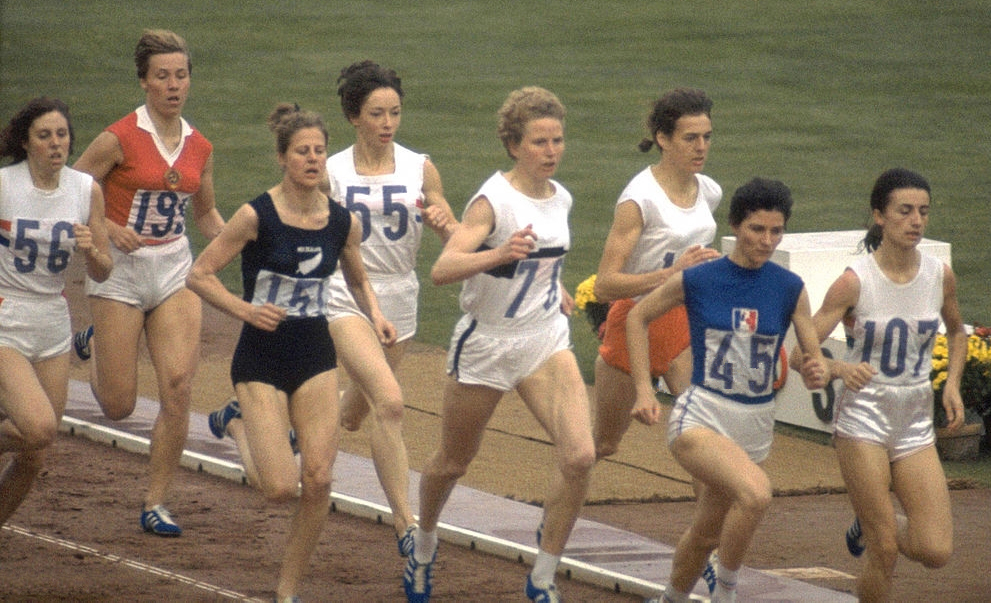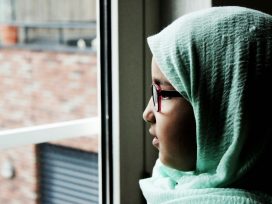My own body had begun to interest me in a new way… Those infamous doses of endorphins would surge through my limbs… This, finally, meant truly living in the body, enjoying movement. (Catriona Menzies-Pike)
As befits a self-proclaimed intellectual, physical education classes in high school were among my least favourite, with the start of each school year being particularly dreadful. This was due to the series of tests and exercises we had to complete, one of which included running laps on the outdoor field. Those infamous six minutes – always seemingly an arbitrarily chosen form of torture (why six?) – were pure horror for me, from my flushed face to my utterly ungraceful flailing limbs. I was never the ‘sporty type’ (ironically, I played volleyball as a child, though, as you can see, it didn’t last). Since I was always taller than average, people frequently asked if I played any sport, and my negative response was often met with a disappointed look, as if I had wasted my potential.
To this day, running remains something I don’t associate myself with and actively avoid (okay, in exceptional situations I will run after the tram – but I hope no one ever has to witness that scene). So, what on earth drew me to The Long Run (V.B.Z., 2024), a book about women’s running? Probably the fact that running is something that the book’s author, Catriona Menzies-Pike, didn’t always identify with (she admits she was primarily a ‘bookworm’). PE classes weren’t her favourite either: she describes herself as having ‘a lack of proprioception, an inability to control her limbs,’ and recounts how, for her ‘and many other clumsy and uncoordinated children, school sports were an experience of intense and frequent humiliation’.
However, at the age of 30, Menzies-Pike laced up her running shoes for the first time and soon found long-distance running to be not just a passion but a form of therapy. She intertwines her testimony of overcoming family trauma through running with the lesser-known history of women’s running and the fight for equality in the sport. Her book, as she puts it, is ‘a personal story that draws on a rebellious portrayal of women’s long-distance running and gives runners like me a little more room to manoeuvre’.
Menzies-Pike started running ten years after her parents were killed in a plane crash. Experiencing movement as both liberation and transformation, she finally found the strength to move forward in life. ‘I realised I had become a runner. Me – a runner?’ she exclaims, surprised by her own transformation. Running helped her rewrite the script of her life, and by working on her physical endurance, she was able to turn her grief ‘into something tangible, like sore muscles and blisters’. Her example reveals that stories of running often serve as a metaphor for deeper personal stories – of transformation, of shedding one’s old skin. Running, one might say, is ‘a versatile metaphor for our inner lives.’
For the purpose of this article, I explored this ‘metaphor for our inner lives’, as well as the very real activity practiced by women of different ages, backgrounds and experiences (running, as Menzies-Pike points out, encompasses a wide spectrum of life experiences and stories that resist generalization). I also conducted a short anonymous survey among female readers of Vox Feminae, with a selection of their responses included in this text. I discovered that some respondents had always been interested in sports, while others developed a passion for it later in life, taking up running in their twenties or thirties – if not even later. The motivations for running varied: (mental) health, coping with stress, building strength and endurance, affordability and accessibility, the ability to fit it into one’s own schedule, pushing personal limits and enjoying time in nature.
A poorly told story
Menzies-Pike observes that historical portrayals of female runners are extremely limited, leaving women without role models to motivate and inspire them to take up the activity. While historical, mythological, literary and other narratives about women running often depict them fleeing danger (usually from a man), ‘men run to hunt, for sport, to chase women, to escape monotony, in pursuit of fame and wealth, or even for the joy of movement’.
Here she rightly asks, ‘where is the glory of the female body in motion? Where are the women who run because it feels good, or to get where they want to go, or to express their desire for even greater freedoms?’ Her book makes a valuable contribution to the representation of the female body in motion, one that is liberating, fulfilling and an end in itself.
One of the earliest recorded instances of women taking part in a sporting event was the Heraean Games in ancient Greece (6th century BCE), where young, unmarried women competed in a footrace. The winners received an olive wreath and a portion of a cow sacrificed to Hera. At the time, women were not even allowed to watch the Olympic Games, let alone participate.
In 1903, France hosted La Marche des Midinettes, a race for female garment workers, organised by the Le Monde Sportif newspaper as a type of media spectacle. Reportedly, 2,500 participants ran from Paris to Nanterre (12 km), followed by tens of thousands of spectators. However, reactions in the media were largely mocking and sexist, and the race itself was seen as definitive proof that competitive sports were not for women.
In 1972, for the first time, women took part in the famous Boston Marathon – largely thanks to the efforts of Nina Kuscsik, an athlete and women’s sports advocate. Prior to this, women were only allowed to compete in short and middle-distance races and cross-country events. By 1974, 14 female athletes worldwide had officially run marathons in under three hours, increasing pressure for the marathon to be made an Olympic discipline for women.
In the United States, the earliest long-distance races for women were organized by cosmetics companies such as Avon. The very first U.S. women’s road race was sponsored by Crazylegs, a women’s shaving cream brand. A total of 72 female runners took part in the Crazylegs Mini-Marathon, held in 1972 by the New York Road Runners’ Club. Playboy Bunnies were present at the starting line to ‘entertain’ the crowd. In a clear reflection of the prevailing attitude towards women in running at the time, the two female co-organizers of the race (Nina Kuscsik and the American runner Kathrine Switzer) were asked by photographers to lift their skirts and show ‘a little skin’ (which they refused to do). Over time, however, the public’s interest in marathons grew, and the race is still held today as the New York Mini 10K Women’s Race, welcoming around 10,000 participants (including non-binary people and a few men).
The first women’s marathon to be officially recognized by the world’s largest athletic organizations was held on 28 October 1973 in Waldniel, West Germany, though it would be another 11 years before the event was to appear at the Olympic Games: the women’s marathon finally made its debut at the 1984 edition of the Games in Los Angeles.
The view from Croatia
In my native Yugoslavia, athletics began to develop rapidly after World War II. The mid-century physical education movement opened up the sport to a wider audience, competitions were organized, and professional associations were founded.
However, it wasn’t until the 1970s that long-distance road and trail running (as opposed to track athletics) began gaining popularity in Yugoslavia. Most races were held in the Croatian cities of Zagreb and Varaždin, though a challenging 25-km road race called the ‘Partisan March’, which took place around the village of Kumrovec on the Croat-Slovene border, had been popular since 1953. Also known as the ‘Brotherhood and Unity Run’, it initially featured only professional athletes, before later opening to recreational runners.
In Croatia, women first competed at the Zagreb-Čazma supermarathon in 1976. Four years later, in 1980, female runners participated in the Kumrovec race for the first time (62 of the 532 runners were female) as well as the YASSA marathon in Varaždin the same year.
The first edition of the Zagreb Marathon, on 11 October 1992, saw 70 participants finish the race, including just four women. Slavica Brčić was the fastest female runner in both the first and second editions of the Zagreb Marathon, finishing 20th in the first race and 13th overall (m/f) in the second. She also competed in the Boston Marathon and was one of the few female athletes who returned to the sport after giving birth (in one magazine article she credited this to the strong support of her husband).
At the Mediterranean Games, women did not compete in long-distance races, but in 1971 Vera Nikolić won the first place in the mid-distance races at 800 m and 1500 m. That same year, she also became European champion in the 800 m race in Helsinki.
Since the 1990s, Croatian women have achieved notable results; in addition to the aforementioned Slavica Brčić, Lisa Stublić Nemec was the top female finisher at the Zürich Marathon in April 2013, for which she was named women’s European Athlete of the Month; Veronika Jurišić came third in the Spartathlon, one of the biggest ultramarathon races in the world; and Tijana Pavičić set national records in the marathon, 10,000 m and 5,000 m.
Corporate cash-ins or empowering events?
One of the most famous women’s sponsor-driven races today is Nike’s ‘She Runs’, which Catriona Menzies-Pike discusses in her book: she participated in the ‘She Runs the Night’ 10-km race in Sydney in 2014. Menzies-Pike describes the race as ‘shockingly pink’, a dominant colour palette that makes it ‘a true tour de force of monochrome branding’, and she admits having ‘mixed feelings’ about such events. On the one hand, they represent corporate whitewashing, carefully avoiding political issues (‘no one even mentioned domestic violence or sexual harassment’, she notes). On the other hand, these races emphasize participation over competition, provide safe spaces and have empowered generations of women runners.
In the Croatian context, the most well-known women’s race is likely the DM Women’s Run, which is held in Zagreb every summer. I was curious whether Vox Feminae readers had ever participated and what they thought about such events. Among the positive comments, the motivating and supportive environment stood out, as well as the encouragement for women to engage in sports:
I participated in the DM Women’s Run once. There are more women in amateur running, so such races are appealing. I know women who were inspired by this event to take up running (at least occasionally) because they find other races too serious or too competitive.
I really like these kinds of events because I think they are a great way to raise awareness about social issues that are not talked about enough.
I like the concept. Not because women are incapable of competing with men, but it’s nice that some events are dedicated to women.
On the other hand, some respondents felt that there was no need to separate races by gender, or they criticized the corporate aspect of such events:
On the one hand, it’s really empowering to see women running together (even in TV shows and movies, which is quite rare), but on the other hand, I don’t see any reason for separation in a sporting context.
I don’t like it when differences between people are unnecessarily emphasized, and in this case, it highlights that women and men are not equal.
I don’t participate in races organized solely by brands for their marketing because their ultimate goal is not people’s health but sales and visibility.
The tyranny of the male gaze
Referring to her participation in ‘She Runs the Night’, Menzies-Pike explains how running alongside thousands of women at night in a park is a unique experience, considering that most women tend to avoid such spaces after dark. ‘Anyone who has ever felt fear while walking home alone at night understands the power of filling dark streets with light and energetic human bodies’, she writes, highlighting that safety in public spaces is a universal concern for women.
Most women have experienced discomfort while running alone, especially at night. ‘A woman running alone is seen as taking a risk or being irresponsible’, writes Menzies-Pike. ‘We are taught to be careful: someone might be watching, and that someone might be dangerous’. In an interview, Nina Kuscsik mentions how, in the 1970s, police officers would approach her during training and ask if she was okay, assuming that she must be running because she was being chased. As Menzies-Pike points out, women running for reasons other than to escape danger is a relatively recent phenomenon.
Although today they may be less likely to be fleeing from trouble, women still cannot escape unwanted gazes: they are scrutinized, assessed, admired, stared at and spied on. ‘We are not connected by some essential experience of womanhood, but we all have to endure this attention’, says Menzies-Pike. Even today, women generally avoid training in the dark and in isolated locations, as I learned from the female runners who participated in my survey.
Although most of them stated that they had not experienced harassment (except verbal – catcalling, unwanted comments, honking from drivers, etc.), they generally do not run at night, or if they do, they choose well-lit and/or busier locations:
Once, a man on a bicycle followed me on an isolated path, and since then, I only run in places where there are other people, and only during the day.
I only had one bad experience at night in [Zagreb’s] Maksimir Park (two drunk men were yelling inappropriate things) so now I avoid dark areas of Maksimir at night.
Frequent comments about breasts, buttocks, and so on. Especially since sweat/cold makes nipples more visible while running. I’m sure men don’t get these comments or feel as afraid to run in the dark or in deserted places.
Challenging preconceptions
The pronounced visibility of women running in public spaces also means there is a certain perception or expectation of what an ‘ideal’ female runner should look like, and many people feel entitled to judge the appearance of female athletes – both amateur and professional – based on arbitrary criteria.
‘Every now and then, someone finds out I love running, looks me up and down as if they are evaluating a racehorse, and then tells me I look like a runner. What does it mean to tell a woman she looks like a runner?’ asks Menzies-Pike. Well, ‘depending on who you listen to’, she continues, ‘female runners are either too thin, too fat, too masculine, or too muscular’; they are either too sexy or not sexy enough, their faces look gaunt, their breasts look strange. It was precisely because of such comments that Menzies-Pike initially wanted to be invisible while running, to blend into her surroundings, to forget how she looked – so that she could ‘feel nothing but the movement of my limbs through the air’.
In the survey, I asked readers whether they thought there was a certain stereotype or image of what a female runner should look like. While in professional sports there is an idea that a successful female runner should be slim, petite, and toned (though even they are not necessarily built that way), in amateur running, as I learned, ‘you see all shapes and sizes, and results don’t necessarily depend on that’, as one respondent put it.
Although I’m tall and thin, I’m often slower than those who don’t seem to have a runner’s build. There’s no such thing as a runner’s body, at least not in amateur circles.
I definitely used to think that a runner should be young, thin and tanned. But through running, I’ve realized that runners come in all sizes, shapes, and ages. I love this so much that one of my long-term goals now is simply to keep running as I get older and become one of those cool grandmas who run in their seventies.
I think the running community is generally much more inclusive toward different body types than people outside it and is more likely to encourage traditionally ‘non-athletic’ individuals to exercise and run.
Regarding the relationship with the body, I was also curious about how running changed the perception of one’s own body and its (in)capabilities among women who train. On the one hand, they feel more comfortable in their own skin and appreciate their bodies more because they have realised they can achieve more than they previously thought. On the other hand, the positive impact on mental health is just as important:
Running has radically changed the way I see my body and its capabilities, especially since I never considered myself athletic and avoided PE as much as possible. Now I perceive my body less from the perspective of what it looks like, and more from what it can do. And that is incredibly emancipating.
I’ve realised that the biggest struggle happens in my own mind when I want to give up. Apart from the fact that my body was formed differently, which gave me additional motivation, I still think that I continued primarily because of the psychological benefits. It helps me unwind after a tough day.
When training gets hard, I remind myself to be grateful that my legs can run and carry me through beautiful landscapes.
A new personal geography
And landscapes, in fact, are something Menzies-Pike highlights as an important part of how running has changed her worldview: beyond the internal transformations in her body and mind, she also experiences a shift in the surroundings through which she moves; that is, she begins to observe it with different eyes – the eyes of a runner. ‘A new geography took hold of me … I lost myself and became part of the scenery’, the author writes. ‘As I ran, my understanding of Sydney’s geography changed … New categories of trees emerged: friendly trees with broad shade; trees with menacing flowers that turn the pavement into a shimmering, slippery danger; trees with unpleasant hard fruits that roll underfoot like ball bearings…’
And my respondents noticed similar changes in themselves, saying that thanks to running, they discovered numerous forest trails and areas; that they now assess distances and time much better; that they view every place through the lens of whether it’s suitable for running:
Running has completely changed my sense of space. For example, distances that once seemed far now feel completely manageable, and that realization fills me with confidence and security.
Running has made me much more aware of the space around me that I wouldn’t have noticed otherwise. When it’s just you, the track, the music, and your breathing, you have plenty of room to observe and take in everything around you.
All in all, I can confirm that, thanks to this book and the responses from my interviewees, I now feel at least a little less resistant to the idea of running – almost enough to want to try it (whether that actually happens remains to be seen)! In any case, as we age – especially those of us who spend most of our days sitting at a computer and aren’t particularly inclined toward exercise – physical activity becomes increasingly important, both for physical and mental health.
And running comes in many forms: you can run on your own or as part of a sports club, with friends or with a dog, you can train for yourself or participate in races, you can run through the city or in nature, you can use the time to let your thoughts wander after a stressful day or to listen to the latest true crime podcast. All you need are running shoes and a little determination:
Running has changed my life and makes me happy, and it is also very emancipating.
Running is more fun and easier than it seems.
This article was first published by Vox Feminae. Its translation from Croatian into English was commissioned as part of Come Together, a project leveraging existing wisdom from community media organization in six different countries to foster innovative approaches.









